Sidelobe Reduction in Non-Contiguous OFDM-Based Cognitive Radio Systems Using a Generalized Sidelobe Canceller
Abstract
:1. Introduction
2. Data Model
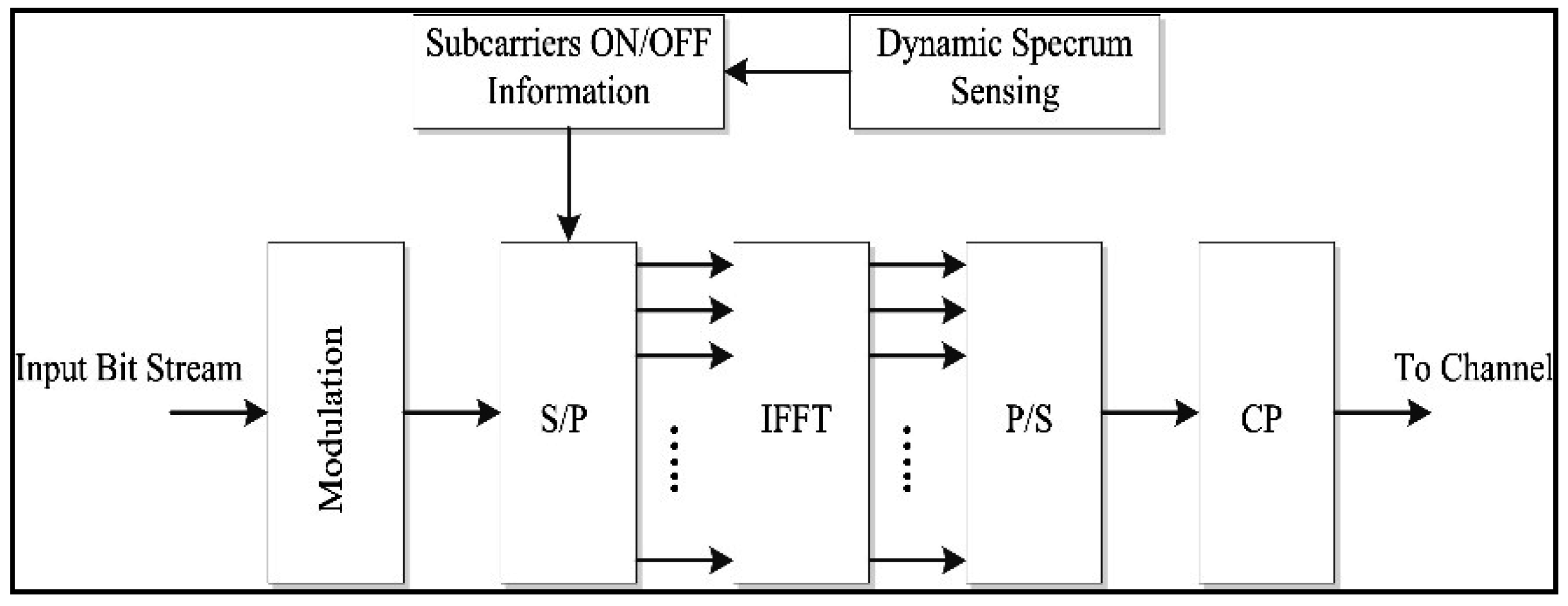
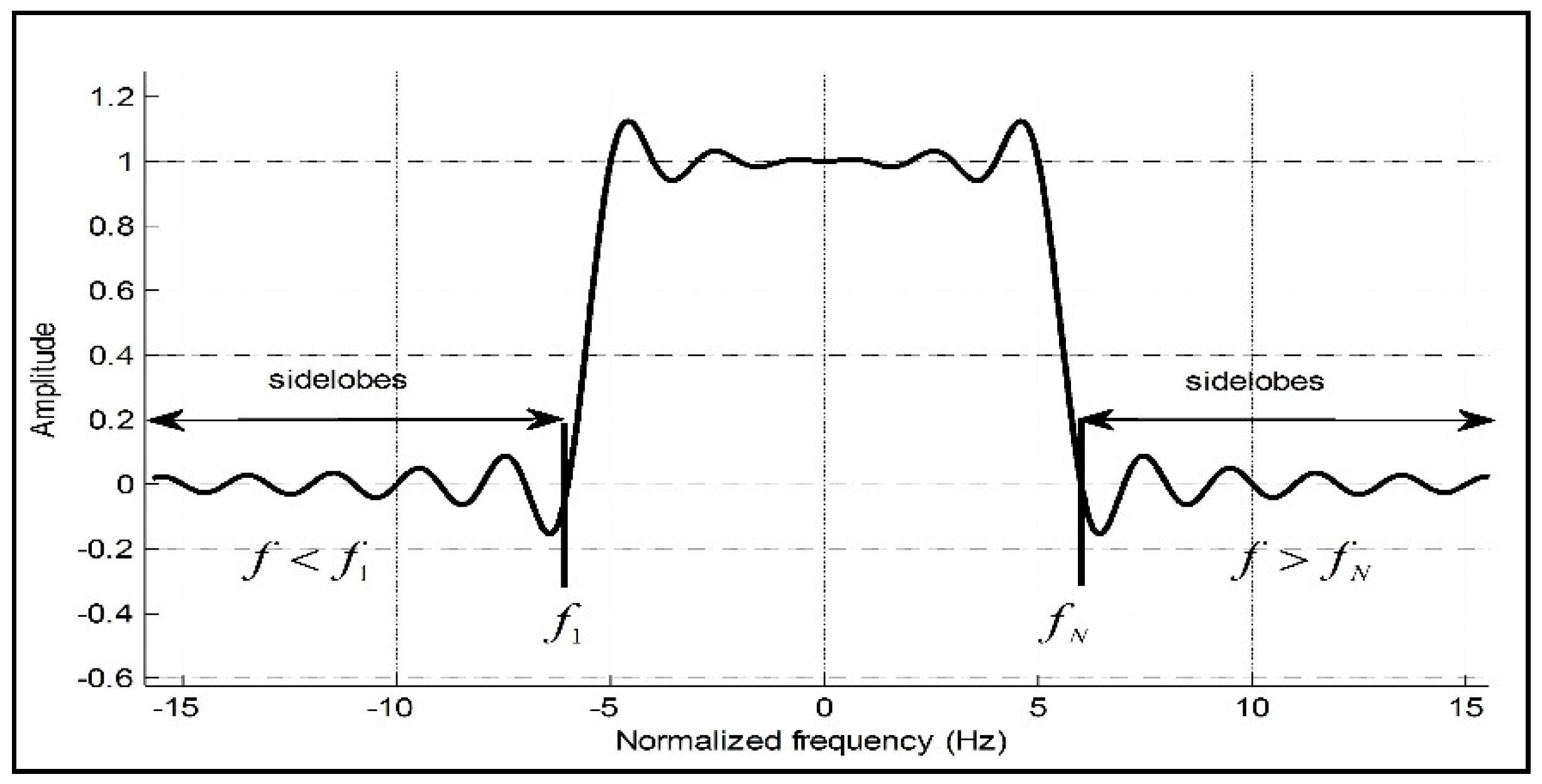
3. Proposed Methodology
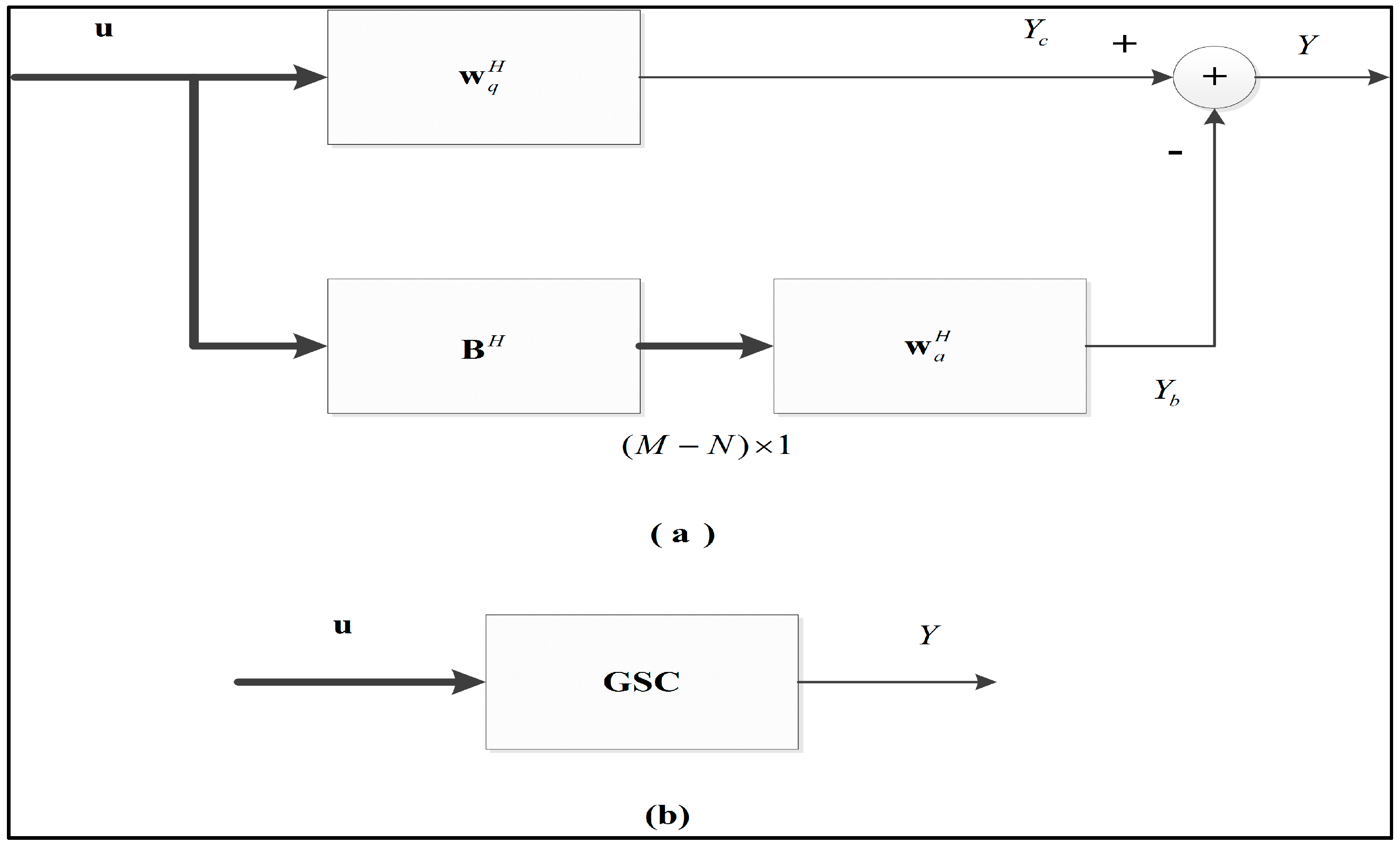
4. Simulations and Results
4.1. Case I
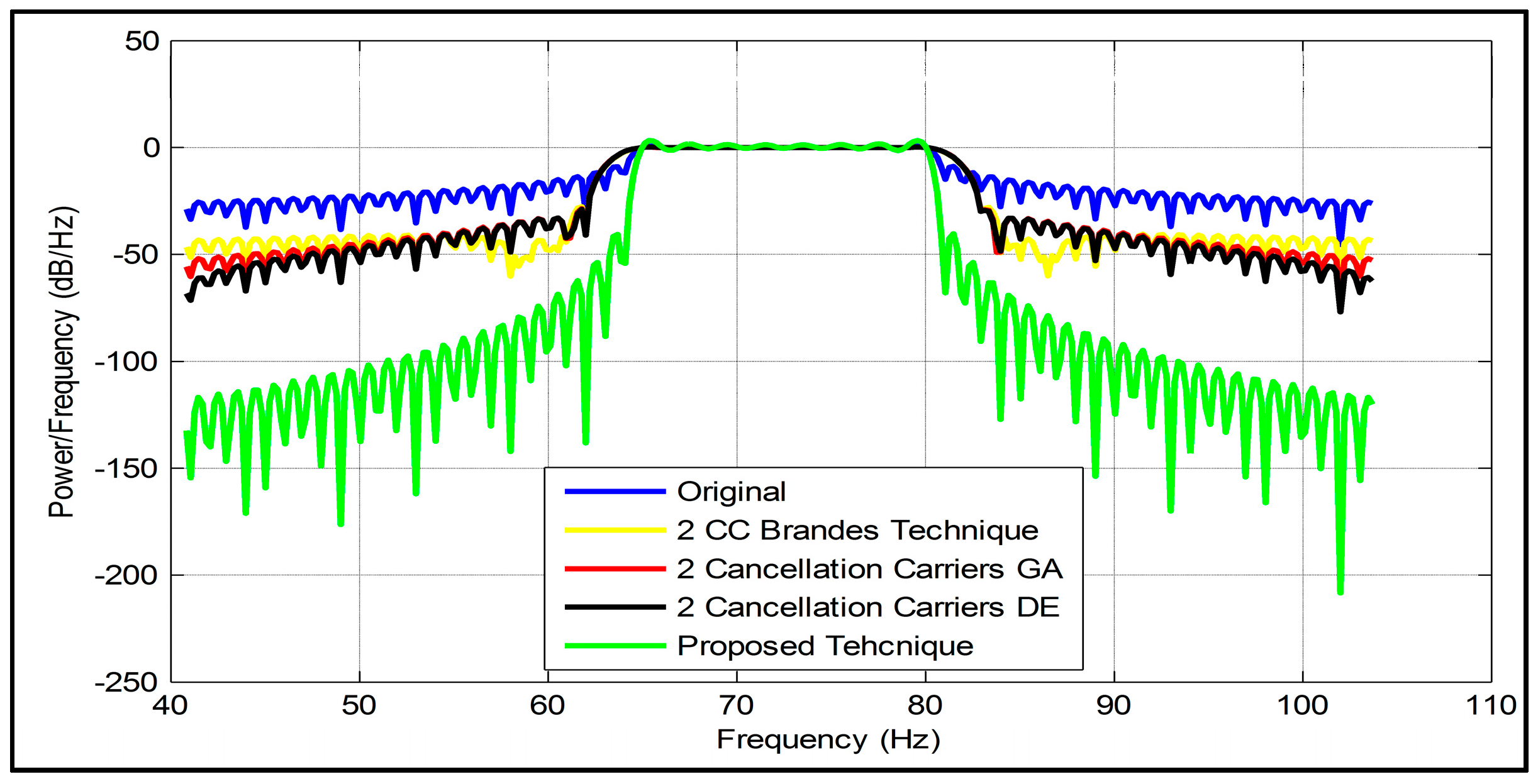
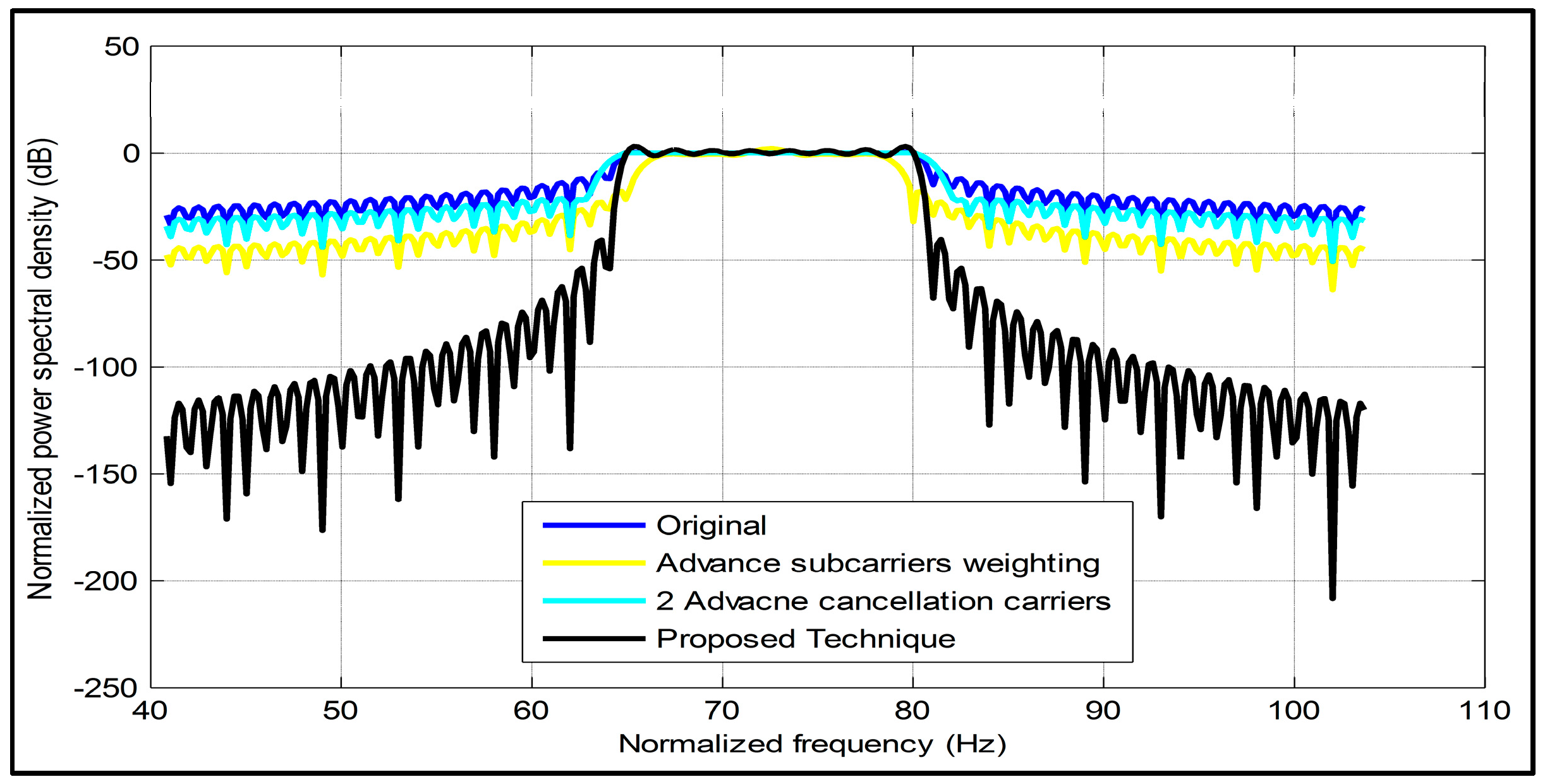
| Techniques used | Sidelobe Powers | |
|---|---|---|
| Left Side of the Data Subcarriers | Right Side of the Data Subcarriers | |
| Original | −25 dB | −25 dB |
| CCs (Brandes) | −43 dB | −43 dB |
| CCs (GA) | −52 dB | −52 dB |
| CCs (DE) | −61 dB | −61 dB |
| ACCs | −30 dB | −30 dB |
| ASCW | −45 dB | −45 dB |
| Proposed technique | −117 dB | −117 dB |
4.2. Case II

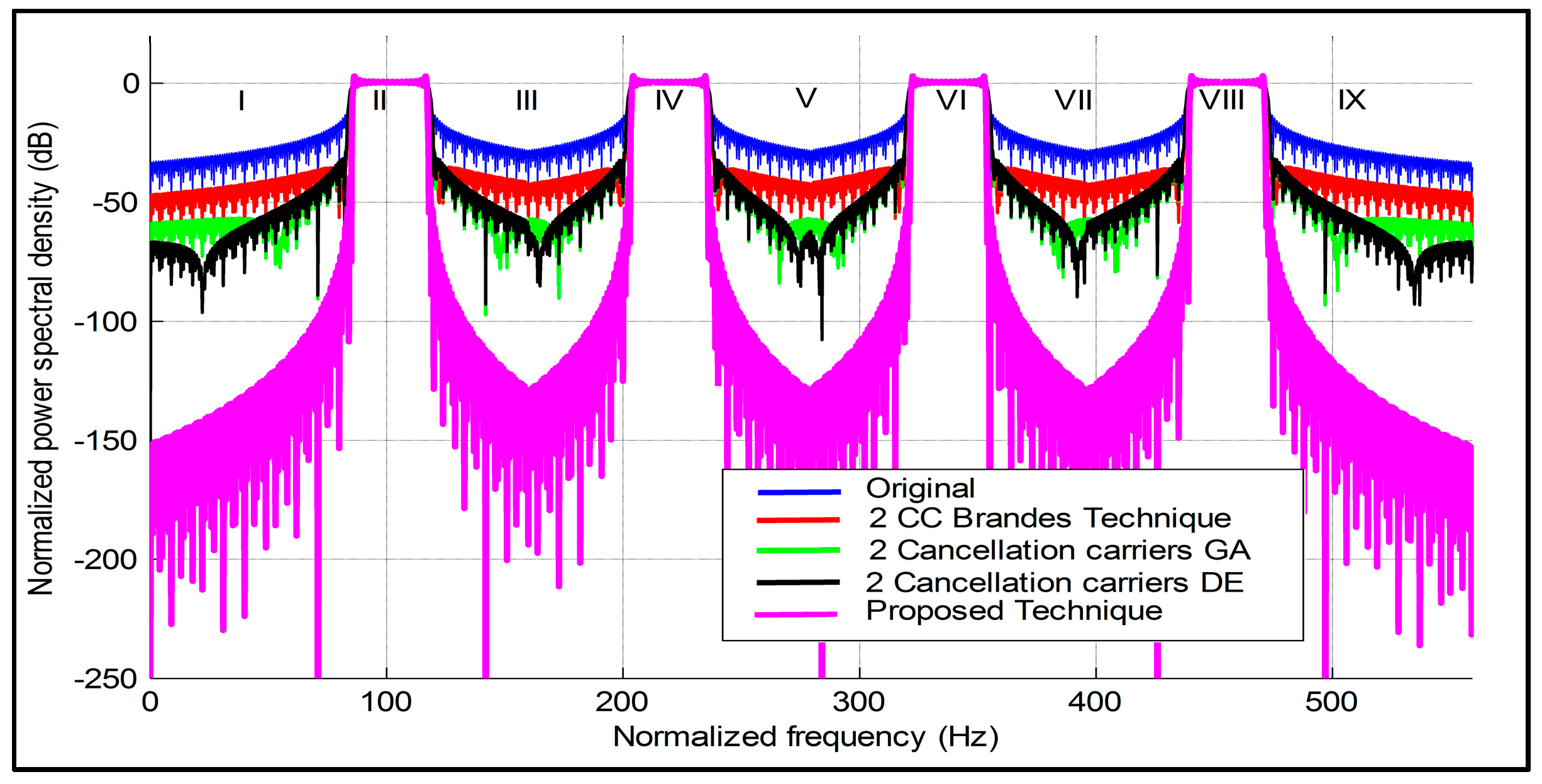
| Techniques used | Sidelobe Power in Regions | ||||
|---|---|---|---|---|---|
| I | III | V | VII | IX | |
| Original | −33 dB | −28 dB | −28 dB | −28 dB | −33 dB |
| CCs (Brandes) | −47 dB | −42 dB | −42 dB | −42 dB | −47 dB |
| CCs (GA) | −59 dB | −57 dB | −57 dB | −57 dB | −59 dB |
| CCs (DE) | −80 dB | −70 dB | −70 dB | −70 dB | −80 dB |
| ACCs | −38 dB | −33 dB | −33 dB | −33 dB | −44 dB |
| ASCW | −45 dB | −38 dB | −38 dB | −38 dB | −45 dB |
| Proposed technique | −152 dB | −130 dB | −130 dB | −130 dB | −152 dB |
4.3. Case III

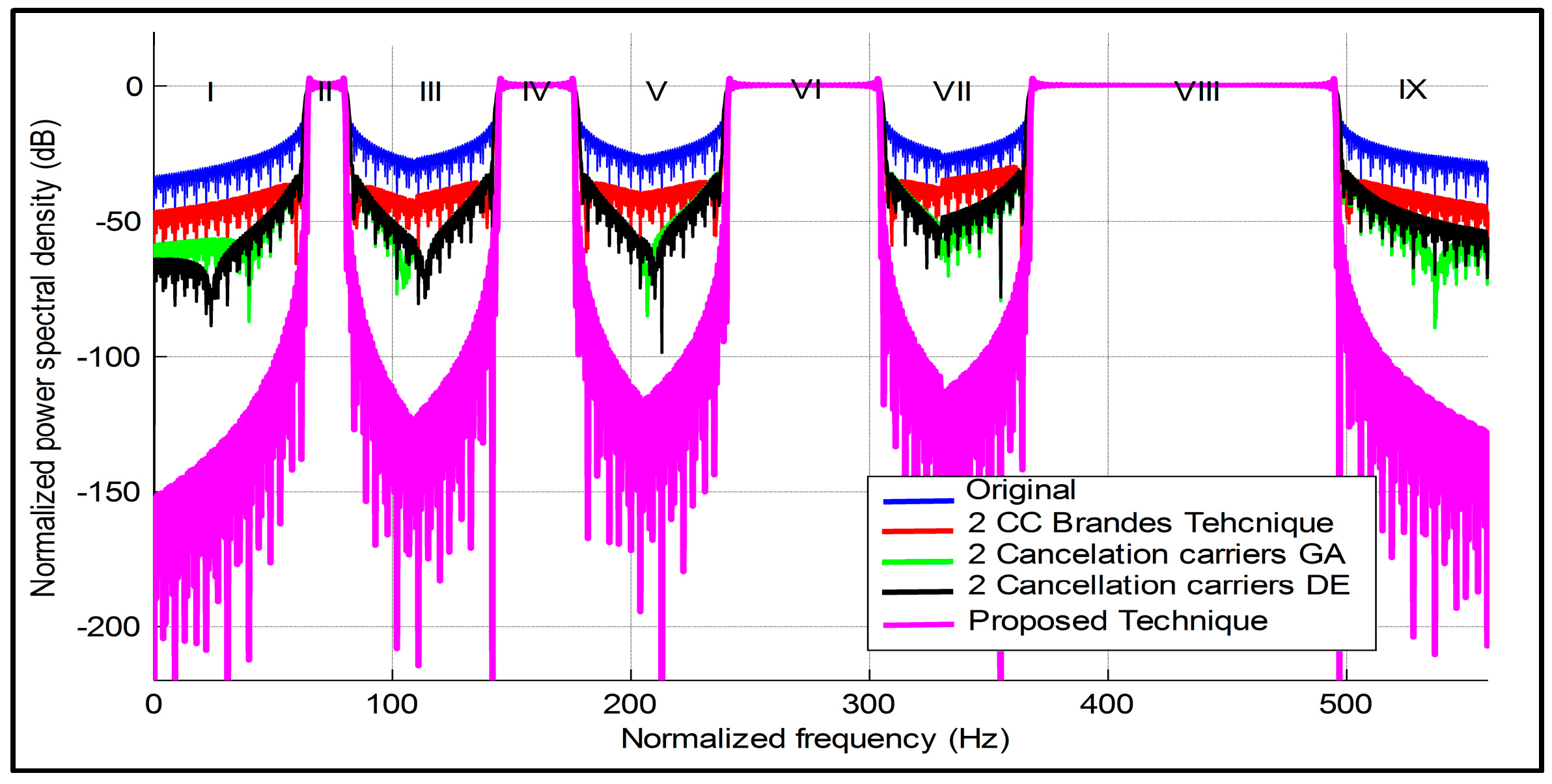
| Techniques used | Sidelobe Power in Regions | ||||
|---|---|---|---|---|---|
| I | III | V | VII | IX | |
| Original | −31 dB | −30 dB | −28 dB | −30 dB | −30 dB |
| CCs (Brandes) | −45 dB | −43 dB | −42 dB | −44 dB | −43 dB |
| CCs (GA) | −57 dB | −57 dB | −57 dB | −57 dB | −57 dB |
| CCs (DE) | −82 dB | −63 dB | −60 dB | −70 dB | −65 dB |
| ACCs | −36 dB | −34 dB | −34 dB | −35 dB | −34 dB |
| ASCW | −42 dB | −40 dB | −39 dB | −41 dB | −40 dB |
| Proposed technique | −142 dB | −135 dB | −130 dB | −140 dB | −136 dB |
4.4. Case IV

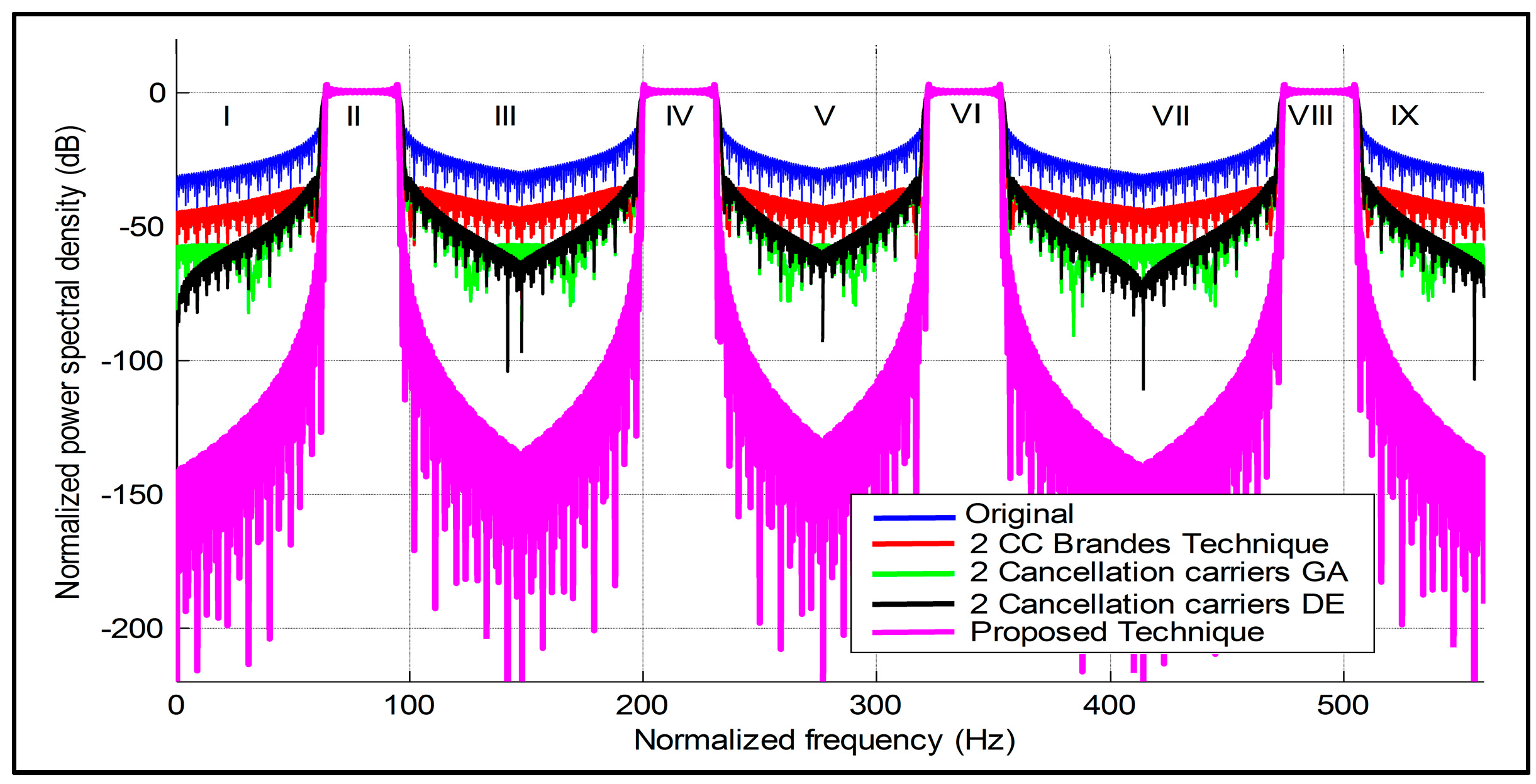
| Techniques used | Sidelobe Power in Regions | ||||
|---|---|---|---|---|---|
| I | III | V | VII | IX | |
| Original | −33 dB | −27 dB | −26 dB | −24 dB | −25 dB |
| CCs (Brandes) | −46 dB | −42 dB | −40 dB | −38 dB | −38 dB |
| CCs (GA) | −59 dB | −58 dB | −40 dB | −52 dB | −54 dB |
| CCs (DE) | −64 dB | −68 dB | −66 dB | −56 dB | −58 dB |
| ACCs | −37 dB | −32 dB | −30 dB | −28 dB | −30 dB |
| ASCW | −44 dB | −38 dB | −34 dB | −30 dB | −35 dB |
| Proposed technique | −152 dB | −125 dB | −118 dB | −114 dB | −127 dB |
4.5. Case V


| Techniques used | Sidelobe Power in Regions | ||||
|---|---|---|---|---|---|
| I | III | V | VII | IX | |
| Original | −30 dB | −29 dB | −20 dB | −27 dB | −32 dB |
| CCs (Brandes) | −45 dB | −42 dB | −35 dB | −41 dB | −46 dB |
| CCs (GA) | −56 dB | −62 dB | −42 dB | −52 dB | −62 dB |
| CCs (DE) | −70 dB | −68 dB | −42 dB | −66 dB | −68 dB |
| ACCs | −35 dB | −34 dB | −26 dB | −32 dB | −38 dB |
| ASCW | −40 dB | −40 dB | −28 dB | −36 dB | −42 dB |
| Proposed technique | −135 dB | −133 dB | −95 dB | −125 dB | −150 dB |
5. Conclusions and Future Work Recommendation
Acknowledgements
Author Contributions
Conflicts of Interest
References
- Chen, K.C.; Peng, Y.J.; Prasad, N.; Liang, Y.C.; Sun, S. Cognitive radio network architecture: Part I–general structure. In Proceedings of the 2nd International Conference on Ubiquitous Information Management and Communication, Suwon, Korea, 31 January–1 February 2008; pp. 114–119.
- Weiss, T.; Jondral, F.K. Spectrum pooling: An innovative strategy for the enhancement of spectrum efficiency. IEEE Commun. Mag. 2004, 42, S8–S14. [Google Scholar] [CrossRef]
- Meucci, F.; Cabral, O.; Velez, F.J.; Mihovska, A.; Prasad, N.R. Spectrum aggregation with multi-band user allocation over two frequency bands. In Proceedings of the Mobile WiMAX Symposium, 2009 (MWS’09), Napa Valley, CA, USA, 9–10 July 2009; pp. 81–86.
- Mahmoud, H.; Yücek, T.; Arslan, H. OFDM for cognitive radio: Merits and challenges. IEEE Wirel. Commun. 2009, 16, 6–15. [Google Scholar] [CrossRef]
- Zhang, Y.; Leung, C. Resource allocation in an OFDM-based cognitive radio system. IEEE Trans. Commun. 2009, 57, 1928–1931. [Google Scholar] [CrossRef]
- Dikmese, S.; Loulou, A.; Srinivasan, S.; Renfors, M. Spectrum sensing and resource allocation models for enhanced OFDM based cognitive radio. In Proceedings of the 2014 9th International Conference on Cognitive Radio Oriented Wireless Networks and Communications (CROWNCOM), Oulu, Finland, 2–4 June 2014; pp. 360–365.
- Noguet, D.; Gautier, M.; Berg, V. Advances in opportunistic radio technologies for TVWS. EURASIP J. Wirel. Commun. Netw. 2011, 2011, 1–12. [Google Scholar] [CrossRef]
- El-Saadany, M.S.; Shalash, A.F.; Abdallah, M. Revisiting active cancellation carriers for shaping the spectrum of OFDM-based cognitive radios. In Proceedings of the Sarnoff Symposium, 2009 (SARNOFF’09), Princeton, NJ, USA, 30 March–1 April 2009; pp. 1–5.
- Sahin, A.; Arslan, H. Edge windowing for OFDM based systems. IEEE Commun. Lett. 2011, 15, 1208–1211. [Google Scholar] [CrossRef]
- Mahmoud, H.; Arslan, H. Sidelobe suppression in OFDM-based spectrum sharing systems using adaptive symbol transition. IEEE Commun. Lett. 2008, 12, 133–135. [Google Scholar] [CrossRef]
- Yamaguchi, H. Active interference cancellation technique for MB-OFDM cognitive radio. In Proceedings of the 34th European Microwave Conference, Amsterdam, The Netherlands, 12–14 October 2004; Volume 2, pp. 1105–1108.
- Wang, Z.; Qu, D.; Jiang, T.; He, Y. Spectral sculpting for OFDM based opportunistic spectrum access by extended active interference cancellation. In Proceedings of the Global Telecommunications Conference, New Orleans, LA, USA, 30 November–4 December 2008; pp. 1–5.
- Qu, D.; Wang, Z.; Jiang, T. Extended active interference cancellation for sidelobe suppression in cognitive radio OFDM systems with cyclic prefix. IEEE Trans. Veh. Technol. 2010, 59, 1689–1695. [Google Scholar]
- Brandes, S.; Cosovic, I.; Schnell, M. Sidelobe suppression in OFDM systems by insertion of cancellation carriers. In Proceedings of the IEEE 62nd Vehicular Technology Conference, Dallas, TX, USA, 25–28 September 2005; Volume 1, pp. 152–156.
- Pagadarai, S.; Wyglinski, A.M.; Rajbanshi, R. A sub-optimal sidelobe suppression technique for OFDM-based cognitive radios. In Proceedings of the Military Communications Conference, San Diego, CA, USA, 16–19 November 2008; pp. 1–6.
- Kryszkiewicz, P.; Bogucka, H. Out-of-band power reduction in NC-OFDM with optimized cancellation carriers selection. IEEE Commun. Lett. 2013, 17, 1901–1904. [Google Scholar] [CrossRef]
- Elahi, A.; Qureshi, I.M.; Zaman, F.; Munir, F. Reduction of out of band radiation in non-contiguous OFDM based cognitive radio system using heuristic techniques. J. Inf. Sci. Eng. in press.
- Selim, A.; Macaluso, I.; Doyle, L. Efficient sidelobe suppression for OFDM systems using advanced cancellation carriers. In Proceedings of the 2013 IEEE International Conference on Communications (ICC), Budapest, Hungary, 9–13 June 2013; pp. 4687–4692.
- Lopes, F.R.; Panaro, J.S. OFDM sidelobe suppression combining active and null cancellation carriers in the guard bands. In Proceedings of the 2013 SBMO/IEEE MTT-S International Microwave & Optoelectronics Conference (IMOC), Rio de Janeiro, Brazil, 4–7 August 2013; pp. 1–5.
- Cosovic, I.; Brandes, S.; Schnell, M. Subcarrier weighting: A method for sidelobe suppression in OFDM systems. IEEE Commun. Lett. 2006, 10, 444–446. [Google Scholar] [CrossRef]
- Selim, A.; Doyle, L. Real-time sidelobe suppression for OFDM systems using advanced subcarrier weighting. In Proceedings of the 2013 IEEE Wireless Communications and Networking Conference (WCNC), Shanghai, China, 7–10 April 2013; pp. 4043–4047.
- Cosovic, I.; Mazzoni, T. Suppression of sidelobes in OFDM systems by multiple-choice sequences. Eur. Trans. Telecommun. 2006, 17, 623–630. [Google Scholar] [CrossRef]
- Li, D.; Dai, X.; Zhang, H. Sidelobe suppression in NC-OFDM systems using constellation adjustment. IEEE Commun. Lett. 2009, 13, 327–329. [Google Scholar] [CrossRef]
- Pagadarai, S.; Rajbanshi, R.; Wyglinski, A.M.; Minden, G.J. Sidelobe suppression for OFDM-based cognitive radios using constellation expansion. In Proceedings of the Wireless Communications and Networking Conference, 2008 (WCNC 2008), Las Vegas, NV, USA, 31 March–3 April 2008; pp. 888–893.
- Selim, A.; Ozgul, B.; Doyle, L. Efficient sidelobe suppression for OFDM systems with peak-to-average power ratio reduction. In Proceedings of the 2012 IEEE International Symposium on Dynamic Spectrum Access Networks (DYSPAN), Bellevue, WA, USA, 16–19 October 2012; pp. 510–516.
- Weiss, T.; Hillenbrand, J.; Krohn, A.; Jondral, F.K. Mutual interference in OFDM-based spectrum pooling systems. In Proceedings of the 2004 IEEE 59th IEEE Vehicular Technology Conference, Milan, Italy, 17–19 May 2004; Volume 4, pp. 1873–1877.
- Wireless LAN medium access control (MAC) and physical layer (PHY) specifications: High-speed physical layer in the 5GHz Band. Available online: http://simson.net/ref/1999/802.11b-1999.pdf (accessed on 19 October 2015).
- Van de Beek, J. Orthogonal multiplexing in a subspace of frequency well-localized signals. IEEE Commun. Lett. 2010, 14, 882–884. [Google Scholar] [CrossRef]
- Ma, M.; Huang, X.; Jiao, B.; Guo, Y.J. Optimal orthogonal precoding for power leakage suppression in DFT-based systems. IEEE Trans. Commun. 2011, 59, 844–853. [Google Scholar] [CrossRef]
- Chung, C.D. Spectrally precoded OFDM. IEEE Trans. Commun. 2006, 54, 2173–2185. [Google Scholar] [CrossRef]
- Van de Beek, J.; Berggren, F. N-continuous OFDM. IEEE Commun. Lett. 2009, 13, 1–3. [Google Scholar] [CrossRef]
- You, Z.; Fang, J.; Lu, I.T. Combination of spectral and SVD precodings for out-of-band leakage suppression. In Proceedings of the 2013 IEEE Long Island Systems, Applications and Technology Conference (LISAT), Farmingdale, NY, USA, 3 May 2013; pp. 1–6.
- Proakis, J.G.; Salehi, M. Digital Communications; McGraw-Hill: New York, NY, USA, 2008. [Google Scholar]
- Goldsmith, A. Wireless communications; Cambridge University Press: New York, NY, USA, 2005. [Google Scholar]
- Nee, R.V.; Prasad, R. OFDM for Wireless Multimedia Communications; Artech House: Norwood, MA, USA, 2000. [Google Scholar]
- Haykin, S.S. Adaptive Filter Theory; Pearson Education India: Pataparganj, Delhi, India, 2008. [Google Scholar]
- Van Trees, H.L. Detection, Estimation, and Modulation Theory, Optimum Array Processing; Wiley-Interscience: New York, NY, USA, 2004. [Google Scholar]
- Khan, M.Z.U. New Methods for Null Steering in the Field of Adaptive Beamforming. Ph.D. Thesis, International Islamic University, Islamabad, Pakistan, 27 March 2014. [Google Scholar]
© 2015 by the authors; licensee MDPI, Basel, Switzerland. This article is an open access article distributed under the terms and conditions of the Creative Commons Attribution license (http://creativecommons.org/licenses/by/4.0/).
Share and Cite
Elahi, A.; Qureshi, I.M.; Khan, Z.U.; Zaman, F. Sidelobe Reduction in Non-Contiguous OFDM-Based Cognitive Radio Systems Using a Generalized Sidelobe Canceller. Appl. Sci. 2015, 5, 894-909. https://doi.org/10.3390/app5040894
Elahi A, Qureshi IM, Khan ZU, Zaman F. Sidelobe Reduction in Non-Contiguous OFDM-Based Cognitive Radio Systems Using a Generalized Sidelobe Canceller. Applied Sciences. 2015; 5(4):894-909. https://doi.org/10.3390/app5040894
Chicago/Turabian StyleElahi, Atif, Ijaz Mansoor Qureshi, Zafar Ullah Khan, and Fawad Zaman. 2015. "Sidelobe Reduction in Non-Contiguous OFDM-Based Cognitive Radio Systems Using a Generalized Sidelobe Canceller" Applied Sciences 5, no. 4: 894-909. https://doi.org/10.3390/app5040894





